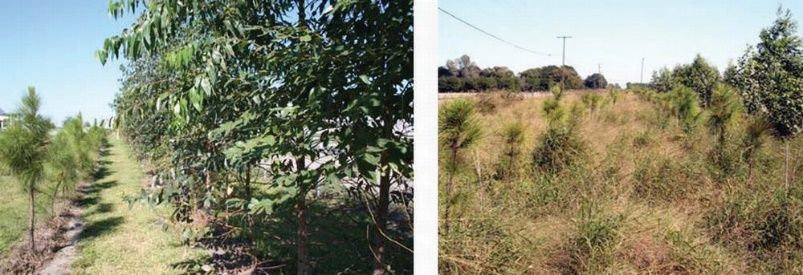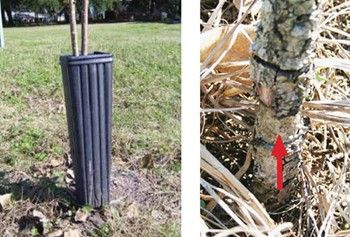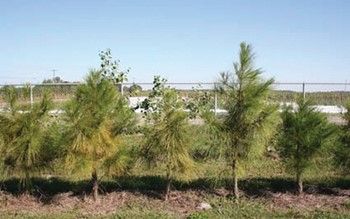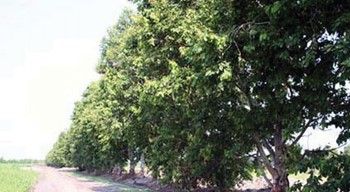In order to obtain maximum benefits from a windbreak, it must be properly managed throughout its lifetime. In the initial years, windbreaks may require as much care as a seasonal crop so they can become well established and maintain vigor, but over time they will require less maintenance and provide the many benefits of increased wind protection for years of crop production. This fact sheet summarizes the most important management practices needing attention from the time the windbreak is planted to when it is replaced.
Windbreak management depends on several factors. These include site conditions where the windbreak is planted (soil and climate), the species used in the windbreak (refer to https://edis.ifas.ufl.edu/fr286 or https://www.crec.ifas.ufl.edu/extension/windbreaks/design.htm), spacing within a row and between rows, and other elements of windbreak design (refer to https://edis.ifas.ufl.edu/publication/fr289). Once these factors have been determined, develop a management plan that includes the following activities.
Management Activities
Irrigation
Irrigation is one of the most important factors influencing windbreak establishment and survival. When constructing a windbreak, ensure the newly planted seedlings receive ample water so that they develop sufficiently and won’t require post-establishment irrigation. The time it takes for a windbreak to become established depends on the species being planted and site conditions at the location where the windbreak is being installed. Once the trees are established, continued irrigation should not be necessary except in severe drought years.
In Florida, water is becoming increasingly limited due to high rates of consumption to support human populations. Consequently, irrigation techniques that follow water conservation practices are best (Gilman).
Drip irrigation conserves water while supplying a sufficient amount to the target area. It directs water specifically where the drip hose is placed. As long as the system is monitored for leaks and clogs and is regulated by a timer, it will work efficiently and use less water than a sprinkler system.
To determine a watering schedule, check the soil moisture by digging an inch into the ground and feeling the soil to see whether it is moist or dry. A reduction in soil moisture over just a couple of days can be fatal to seedlings, so it is important to monitor it when establishing new windbreaks.
Weed Control
Newly planted windbreak trees will likely compete with weeds for moisture, nutrients, and sunlight. Too much competition for these resources can slow tree growth and may even kill your trees. Since some weeds are able to out-compete trees for several years after planting, continue to monitor and control weeds until trees have become established well enough to out-compete weeds on their own (Figure 1).

Credit: Bijay Tamang
To control weeds in and around the windbreak you may use mechanical, chemical, cultivation or barrier methods, or mulches.
MECHANICAL
Mowing is one mechanical method that can be used to control weeds between rows, but don’t mow if the weeds have grown so tall that it is challenging to locate planted trees because you might mow over trees. Weed eaters are also an effective method to keep competition with weeds to a minimum, but they can damage unprotected trees. Protect the stems with plastic tubing to prevent lacerations on the bark, which can result in damage to the cambium (Figure 2). Cambium damage can compromise tree growth, can make a tree more susceptible to blowdown as it matures, and can girdle the tree, which usually kills it.

Credit: Bijay Tamang
CHEMICAL
Selective herbicides that kill herbaceous plants but not woody trees can also be used to control weeds (Figure 3). Pre-emergent herbicides prevent weeds from germinating, while other herbicides kill weeds that are growing. Read labels carefully and select herbicides that will not damage the species in your windbreak. Train personnel who will apply herbicides to distinguish between weeds and the species they are attempting to protect. Anyone can purchase herbicides that do not have restricted-use, but if you need restricted-use herbicides, they must be purchased and applied by a licensed person. Regardless, it is always important to read and follow label instructions to ensure everyone’s safety.

Credit: Bijay Tamang
CULTIVATION / BARRIERS
Weeds can also be controlled by using a weed barrier fabric or in some cases by planting annual crops between rows after trees are established. Cultivation will provide erosion protection while yielding additional crops. Using a weed barrier fabric requires less maintenance initially but still requires care. As weeds grow near and around barriers, care must be taken to ensure that trees do not grow into the plastic and that roots do not envelop the plastic.
MULCHES
Mulching is a great alternative for controlling weeds. Commercially available mulches include wood chips, rubber mulch, and plastic mulch. However, locally available materials such as gravel, leaves, tree bark, and hay can also be used. Properly applied, mulch can keep trees from being damaged by mechanical equipment or killed unintentionally from a poorly aimed chemical treatment. Mulch requires no additional resources to maintain, unlike inter-row crops or plastic barriers. Finally, proper mulching not only prevents weeds from appearing but also maintains soil moisture longer than if there were no mulch. In most cases a 2- to 4-inch layer of either rubber mulch or wood chips will discourage weed development (Gardening Solutions).
Competition Management
Competition between windbreaks and crops for moisture, nutrients, and light can be an issue. This becomes serious if both tree and crop roots use the same area in the soil profile. One way to reduce competition is by pruning the tree roots to the depth occupied by crop roots using commercially available root pruners. Root pruning can increase crop yield in the windbreak-crop interface at least for a few years (Sudmeyer et al. 2002). But tree roots may have to be pruned once every couple of years and pruning becomes difficult with deep-rooted species. Shade-tolerant crops can be used next to the windbreak to reduce the effect of light competition. In areas where access roads and irrigation ditches are widely used, both root and above-ground competition can be reduced by placing access roads on one side of the windbreak and irrigation ditches on the other side of the windbreak (Figure 4).

Credit: Bijay Tamang
Pruning and Thinning
Very dense windbreaks can be as bad as none at all. Turbulence on the leeward side of dense windbreaks can cause more damage to crops than the unobstructed wind (refer to EDIS publication https://edis.ifas.ufl.edu/publication/fr289 for more information). Pruning and thinning may be required for dense windbreaks in order to maintain the desired porosity (ratio of the open portion of the windbreak, where stems, branches, or leaves are missing, to its total volume) and reduce wind turbulence.
Windbreak trees should generally not be pruned but if need be, pruning should focus on young, multi-stemmed trees smaller than 2 inches in diameter (Wray et al. 2005). Young trees with many stems or forking can be pruned to contain only one dominant stem. This will create a single-stemmed tree that will grow taller faster than if it is not pruned.
Branches can also be pruned to create desired porosity (refer to EDIS publication https://edis.ifas.ufl.edu/publication/fr289 for more information), but care should be taken not to create large gaps in the windbreak while doing so (Figure 5).

Credit: Bijay Tamang
With older, more established trees, you may need to thin or remove trees from the windbreak if tree crowns have limited space to grow. The selection of tree(s) to remove will depend on the number of rows in the windbreak and your management objectives. Thinning options include: remove every other tree, remove an entire row, or simply thin around the crowded trees. Remove the trees that have poor vigor, are diseased or are dying, and leave the healthier and perhaps larger trees. Regardless, keep your desired level of porosity in mind so that you don’t inadvertently over-thin.
Disease and Insect Control
It is usually more difficult to control disease and insects in single-species windbreaks because diseases and insects generally target a specific tree species. Once the disease and/or insect infestation has occurred, it can easily spread to other trees. For this reason, it is best to use a combina- tion of species in a windbreak, but in some cases multiple species may not be available during the desired planting time or for your region. If this is the case, choose a single tree species that is known for its pest resistance. No matter what species you use, monitor your windbreak regularly to catch disease and insect damage as early as possible.
Protection from Livestock and Animals
Livestock and animals can cause damage to a windbreak throughout its life. Newly planted seedlings cannot withstand trampling and browsing. Livestock and wild animals such as rabbits, rodents, and deer enjoy browsing on tender leaves and shoots of new growth, which can stunt or kill windbreak species. In more established windbreaks, livestock and deer tend to break off lower branches and remove bark, altering the porosity at the base of the wind- break and possibly compromising the tree.
Protect your windbreak from animals by installing a fence around it. A fence will not only protect the windbreak but also will prevent soil from becoming compacted around it. Keep windbreak areas weed free to discourage smaller mammals like rabbits and rodents, and protect the trees from browsing by placing plastic tubing around seedlings (Figure 2).
Regardless of the age of the windbreak, it is important to protect it from livestock and wildlife in order for it to thrive and function properly throughout its life.
Protection from Herbicide Drift
Several types of herbicides are regularly used in agricultural fields and are easily carried by wind. Herbicide droplets can drift into non-target areas and harm unintended species. Avoid applying herbicide on windy days to minimize herbicide drift damage to trees in the windbreak. Cover short-statured trees near the herbicide application area to minimize exposure.
Windbreak Renovation and Replanting
Monitor windbreaks for growth and survival the first few years after they are planted. Replace dead seedlings right away. If possible, plant a seedling from the original stock. This ensures a more uniform height and spacing throughout the windbreak, which will help to maintain its effectiveness.
Replace trees as they age to avoid empty spaces within the windbreak. This can entail replacing a couple of trees or replacing the entire windbreak depending on the cause and quantity of mortality. To ensure continuous protection from a windbreak, new trees should be established several years before the old trees die. This will allow time for the rejuvenated windbreak to become functional before the old one is no longer effective. Single-row windbreaks can be replaced by establishing a new one just behind or just in front of the existing one. For multiple-row windbreaks, replacement can be challenging due to limited space. One strategy is to replace one of the rows and leave the rest to continue to provide protection while the new row becomes established. When the new row is functional, the rest of the rows can then be replaced.
Management Costs
Management of windbreaks can be costly and time consuming, but with some planning it’s possible to reduce costs (Table 1). Cost-effective methods should be wisely chosen to ensure effective and viable windbreaks. All activities are important, but some of them must be carried out through- out the life of the windbreak, while others are needed only in the earlier phases of their establishment.
Conclusions
Establishing functional windbreaks requires an investment in money, time, and effort. They cannot simply be planted and left to grow for the remainder of their life. Regular monitoring and management is necessary to ensure they are adequately protected. Over time, proper maintenance can reduce overall management costs and increase the functionality and viability of the windbreak.
References
Andreu, M.G., Tamang, B., D.L. Rockwood, and M.H. Friedman. 2009. Potential woody species and species attributes for windbreaks in Florida. FOR224. Gainesville: University of Florida Institute of Food and Agricultural Sciences. Retrieved August 14, 2009 from http://edis.ifas.ufl.edu/fr286
Gardening Solutions, UF/IFAS. (n.d.). Choosing and installing mulches. Gardening Solutions - University of Florida, Institute of Food and Agricultural Sciences. Retrieved January 11, 2022, from https://gardeningsolutions.ifas.ufl.edu/care/planting/mulch/
Gilman, E. F. (n.d.). Irrigation management after planting. UF/IFAS. Retrieved January 11, 2022, from https://hort.ifas.ufl.edu/woody/irrigation2.shtml
Sudmeyer, R.A., D.J.M. Hall, J. Eastham, and M.A. Adams. 2002. The tree-crop interface: the effects of root pruning in south-western Australia. Australian Journal of Experimental Agriculture 42:763-772. https://doi.org/10.1071/EA02012
Tamang, B., M.G. Andreu, M.H. Friedman, and D.L Rockwood. 2009. Windbreak planting and designs for Florida agricultural fields. FOR227 Gainesville: University of Florida Institute of Food and Agricultural Sciences. https://edis.ifas.ufl.edu/publication/fr289
Wray, P., L. Sternweis, and J. Lenahan. 2005. Farmstead windbreaks: establishment, care, and maintenance. Iowa State University Extension publication, https://naturalresources.extension.iastate.edu/files/encyclopedia/files/farmstead_windbreaks_establishment.pdf, Ames, IA.
Table 1. Relative cost for different windbreak management practices and their frequency.